Tudor Revival Interior Design: Blending Historic Charm with Modern Comfort in Your Home
There’s an undeniable magic in old homes, a silent narrative whispered through their walls. Among these, the Tudor Revival style stands out, captivating homeowners and design enthusiasts alike with its profound sense of history, stability, and unparalleled coziness.
Characterized by its iconic dark wooden beams, majestic stone fireplaces, and an overall ambiance of warmth and comfort, this architectural and interior design style evokes a strong, comforting feeling of permanence. It’s a design philosophy that connects us to a rich past while providing a sanctuary in the present.
This comprehensive guide is crafted to help you:
- Deeply understand the unique characteristics that define Tudor Revival interiors.
- Explore practical strategies for seamlessly incorporating this distinctive style into your own living spaces.
- Discover innovative ideas to infuse modern freshness into your Tudor-inspired home without compromising its authentic, original charm.
The allure of this peaceful and solidly built aesthetic is experiencing a significant resurgence. You’ll notice its presence growing across online platforms and in design publications, as more people are actively seeking to replicate its unique blend of heritage and comfort within their contemporary homes. This guide will walk you through every step of bringing this captivating style into your own residence.
What Defines a Tudor Revival Interior? Understanding Its Rich Heritage
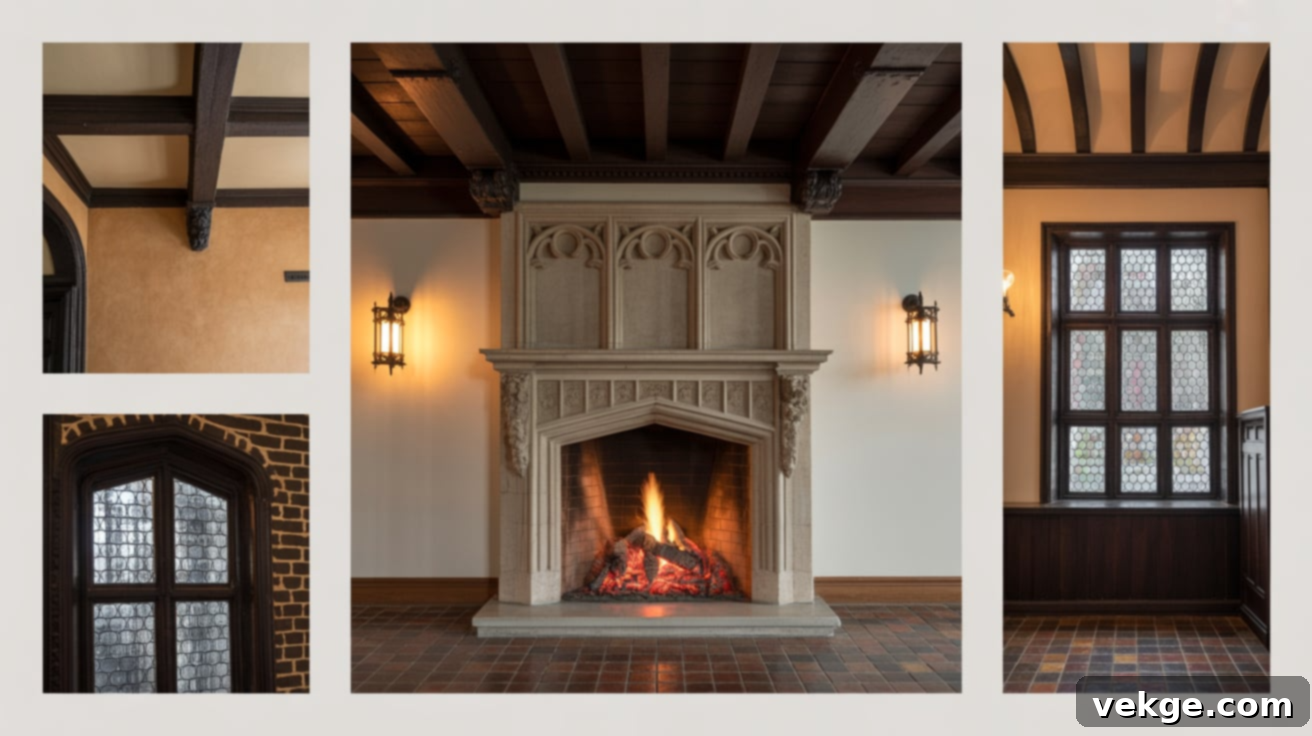
Tudor Revival interiors draw their profound inspiration from the grand, yet often rustic, medieval English homes of the 16th century. This distinctive style surged in popularity across the United States during the early 20th century, particularly from the 1890s to the 1940s. These homes were meticulously crafted to mimic the appearance of centuries-old structures, complete with charming anachronisms, yet designed to offer all the modern comforts and conveniences of their time. The “revival” aspect implies a nostalgic look back to a romanticized past, translating those historical elements into a livable, appealing aesthetic for a new era.
Key Elements of Authentic Tudor Revival Interior Design
When you step into a well-preserved or thoughtfully designed Tudor Revival home, certain recurring architectural and decorative features immediately capture your attention. These aren’t merely decorative details; they are fundamental components that collectively weave the distinctive, cozy, and anchored feeling of the space. Understanding these elements is crucial for anyone looking to embrace or enhance this style in their own home.
- Exposed Wood Beams and Paneling: These are perhaps the most iconic features, bringing immediate warmth, texture, and a sense of history to ceilings and walls. Often crafted from dark-stained oak or similar robust timbers, these beams help to visually ground the space and create an intimate, lived-in atmosphere reminiscent of old English manor houses. Wall paneling, especially wainscoting, further enhances this feeling of sturdy craftsmanship and traditional elegance.
- Large Stone Fireplaces: Serving as the undisputed heart of any Tudor Revival living area, these grand fireplaces are typically constructed from rough-hewn stone, brick, or even carved wood. Often towering and impressive, they provide not just physical warmth but also a powerful visual anchor for the room, inviting gathering and conversation. The mantelpiece often becomes a focal point for decorative display.
- Plaster or Stucco Walls: Unlike the smooth, pristine surfaces of more contemporary styles, Tudor Revival walls frequently feature plaster or stucco finishes. Their intentionally uneven, hand-troweled texture adds a soft, organic quality to the room, preventing the heavy wood elements from feeling too stark or overwhelming. This subtle texture contributes significantly to the style’s overall warmth and artisanal charm.
- Leaded-Glass Windows: These small-paned windows, often set in diamond or rectangular patterns within a larger frame, are a hallmark of the style. They don’t just let in natural light; they filter it gently, creating intricate patterns of light and shadow that dance across the room. These windows add a delicate yet distinctive design detail, making a home feel more personal, private, and deeply connected to its historical roots.
- Patterned Brick or Wood Floors: The flooring in Tudor Revival homes is typically robust and rich in character. Patterned brick, often in herringbone or basketweave designs, or dark, wide-plank wood floors (like oak or chestnut) are common. These traditional flooring choices provide a strong foundation for the space, linking it to the past while adding significant depth and texture underfoot.
Color Palettes & Materials for Authentic Tudor Revival Interiors
Traditionally, Tudor Revival interiors are steeped in a rich, earthy palette of deep greens, robust burgundy reds, muted grey stones, and the profound, dark tones of oak wood. While this classic palette offers immense depth and historical accuracy, it can sometimes feel heavy for modern sensibilities. The good news is that you can easily adapt these elements to create a lighter, more contemporary feel without sacrificing the style’s inherent charm.
Today, designers often lean towards a refreshed palette incorporating warm whites, softened muted browns, and gentle greys. These lighter shades help to brighten the interior, making rooms feel more expansive and airy, allowing the architectural details to shine without overwhelming the space. This approach ensures that you can retain the cherished old-world charm while still enjoying a home that feels bright, welcoming, and comfortable in natural daylight. When selecting materials, remember that not every piece needs to be an antique or sourced from a period property. Embrace the spirit of the style using new materials that mimic the old.
Consider using reclaimed wood for accent walls or for crafting faux ceiling beams. These options are not only cost-effective but also contribute to the authentic, weathered look that is so central to Tudor Revival. Combining natural materials like stone, wrought iron, and heavy textiles will further enhance the tactile and visual richness of your interior.
Modernizing Tudor Interiors Without Sacrificing Class or Character
You might deeply appreciate the inherent warmth and historical depth of the Tudor style, yet still desire a living space that feels current, bright, and functionally relevant for today’s lifestyle. Achieving this balance is where thoughtful design truly shines. Modernizing a Tudor Revival home is about intelligent integration, not wholesale replacement.
- Strategic Layout Adjustments: Begin by evaluating your home’s layout. Many older Tudor homes feature smaller, more segmented rooms. If appropriate and structurally feasible, carefully removing a non-load-bearing wall can dramatically open up a space, creating better flow and an airier feel. The key is to be selective; endeavor to preserve original architectural features such as existing exposed beams, distinctive archways, or intricate door frames wherever possible. These elements are invaluable for retaining the home’s unique character amidst modernization.
- Softening Heavy Tones with Light Neutrals: To counteract the often-heavy visual weight of dark wood and stone, introduce a palette of light, calming neutrals. Think crisp white walls, sumptuous cream-colored fabrics for upholstery, and pale, textured rugs. These choices will instantly brighten the space, making it feel more contemporary and expansive without stripping away its historical personality. This contrast highlights the richness of the dark wood while providing visual relief.
- Thoughtful Furniture and Lighting Mix: Integrate clean-lined, contemporary furniture pieces alongside your cherished vintage or antique items. Imagine a sleek mid-century modern armchair elegantly paired with an ornate antique writing desk, or a minimalist sofa complementing a grand, carved wooden coffee table. This juxtaposition creates visual interest and showcases both styles. Furthermore, update lighting fixtures; modern pendant lights, sleek floor lamps, or bold, sculptural artwork can introduce a contemporary edge and provide much-needed contrast, preventing the space from feeling too static or dated.
Tudor Revival Room-by-Room Ideas: Crafting Cohesive Spaces
This section provides actionable and simple ideas for integrating Tudor Revival charm into every room of your home. The goal is to maintain that enchanting old-world aesthetic while ensuring each space remains highly functional and comfortable for daily living.
1. The Welcoming Living Room: Heart of the Tudor Home

In the quintessential Tudor-style home, the grand stone fireplace is not just an architectural feature; it is unequivocally the heart and soul of the living room. Design your furniture arrangement to naturally face this central element, allowing the hearth to serve as the dominant visual anchor. A symmetrical arrangement, such as a pair of comfortable armchairs flanking the fireplace, adds a sense of balanced formality, while a deep, plush sofa invites ultimate relaxation. To introduce depth and a luxurious texture, opt for heavy, insulated curtains in rich, earthy tones like deep moss green, warm burgundy, or muted gold. A woven area rug featuring a faded geometric or subtle floral pattern will add both softness underfoot and a layer of historical authenticity to the space. For lighting, prioritize fixtures that emit a warm, inviting glow. Wrought iron wall sconces or lamps with natural linen shades are ideal for softening the architectural lines and creating an intimate, cozy ambiance.
2. Timeless Kitchen Updates for a Tudor Revival Home
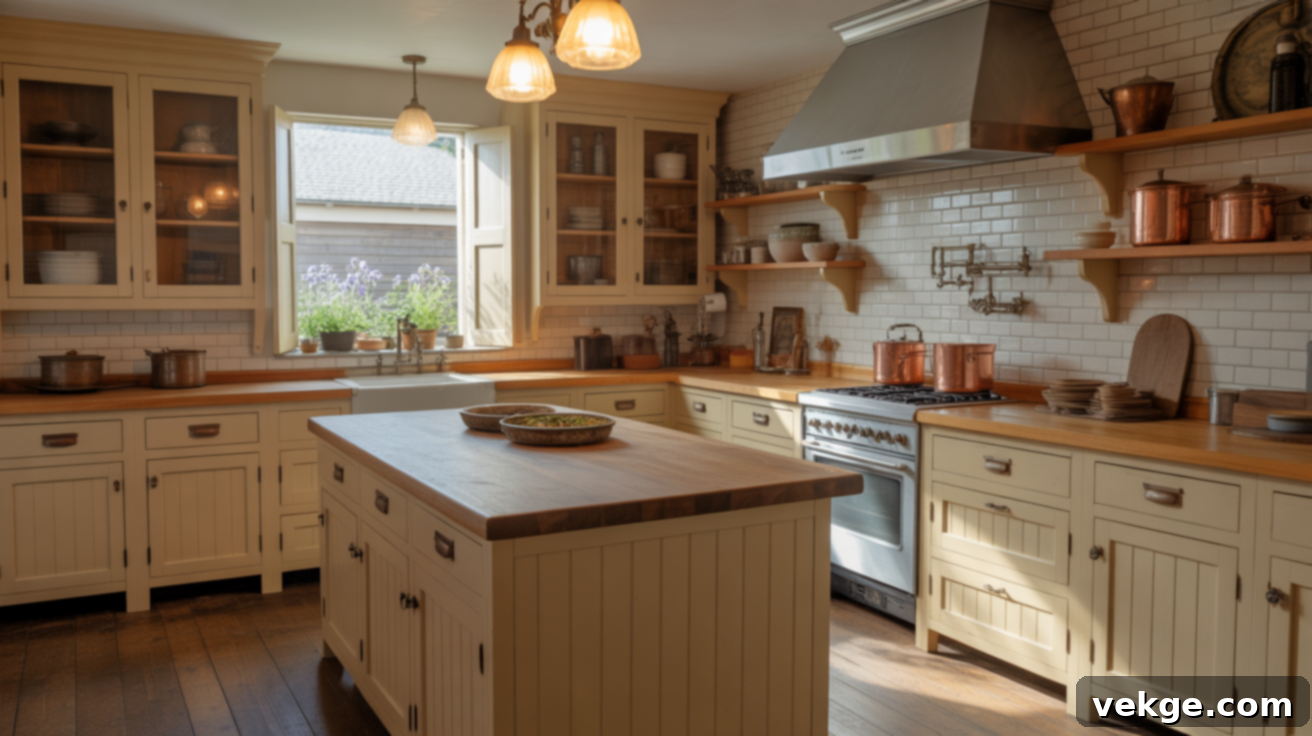
For kitchen cabinetry, Shaker-style fronts are an excellent choice as they beautifully complement the understated craftsmanship of Tudor Revival. Select them in muted shades such as creamy off-white, soft sage green, or sophisticated charcoal grey. Elevate the cabinets with hardware in finishes like warm copper, classic oil-rubbed bronze, or elegant brushed brass to introduce a touch of warmth and period authenticity. For the backsplash, choose timeless off-white or ivory subway tiles, arranged in a classic running bond or herringbone pattern, ensuring a clean yet traditional look. Incorporate open shelving crafted from natural, robust wood to elegantly display essential kitchenware such as handcrafted stoneware, decorative cutting boards, or antique kitchen scales. If space permits, a sturdy butcher block island or a rustic farm-style table will provide invaluable extra workspace and perfectly align with the older, grounded feel of the house, enhancing both function and aesthetics.
3. Creating a Charming Tudor Revival Bathroom
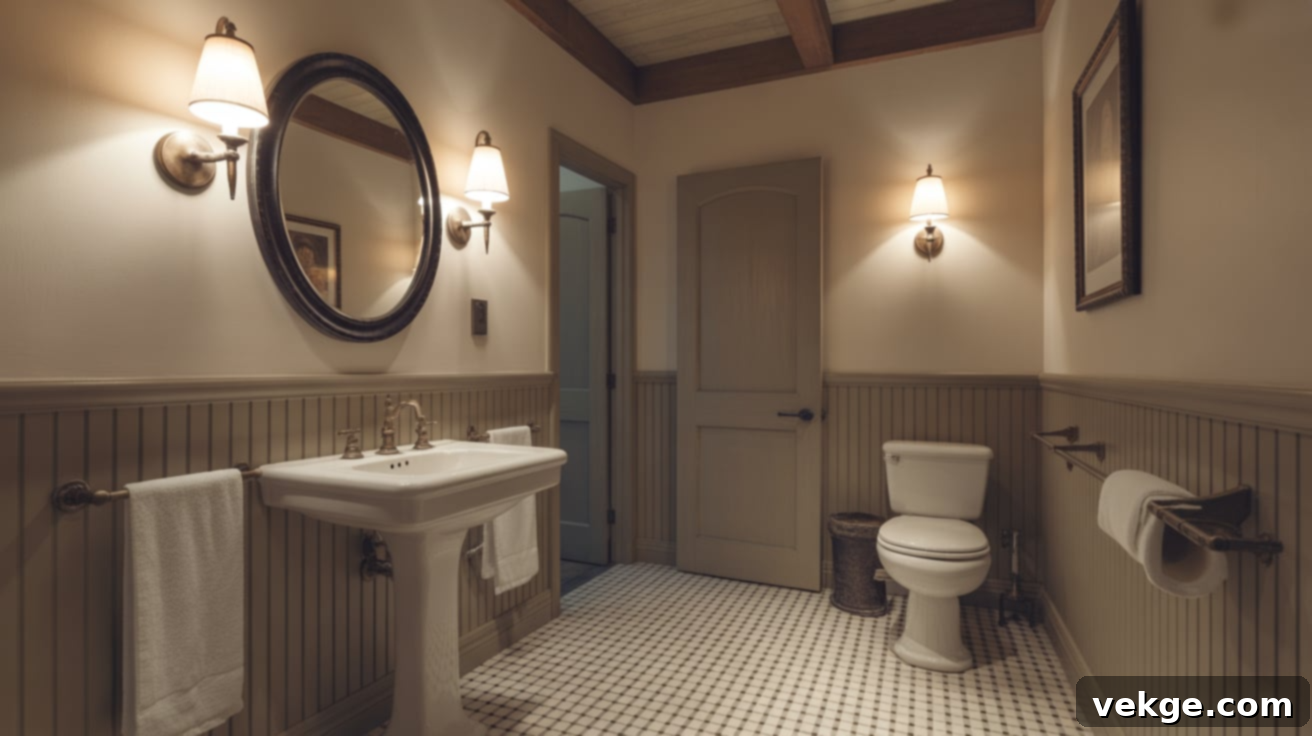
In the bathroom, a classic pedestal sink is highly functional and helps maintain an open, uncluttered feel, which is beneficial in smaller spaces. For flooring, consider timeless black-and-white tiles arranged in a checkerboard or herringbone layout to add a touch of vintage sophistication. It’s crucial to avoid anything overly polished or gleaming; fixtures should possess a slightly aged, antique finish, such as brushed nickel, oil-rubbed bronze, or even unlacquered brass that will patina over time. For mirrors, opt for rounded or oval frames in dark metal or a rich, dark-stained wood to echo the home’s overall aesthetic. Keep wall colors neutral, perhaps warm whites or soft greys, and introduce texture with wainscoting or by exposing existing wooden beams. Soft, diffused lighting from wall-mounted sconces will prevent the space from feeling too harsh or sterile, enhancing the overall period charm.
4. Bedrooms: A Cozy Retreat in Tudor Style
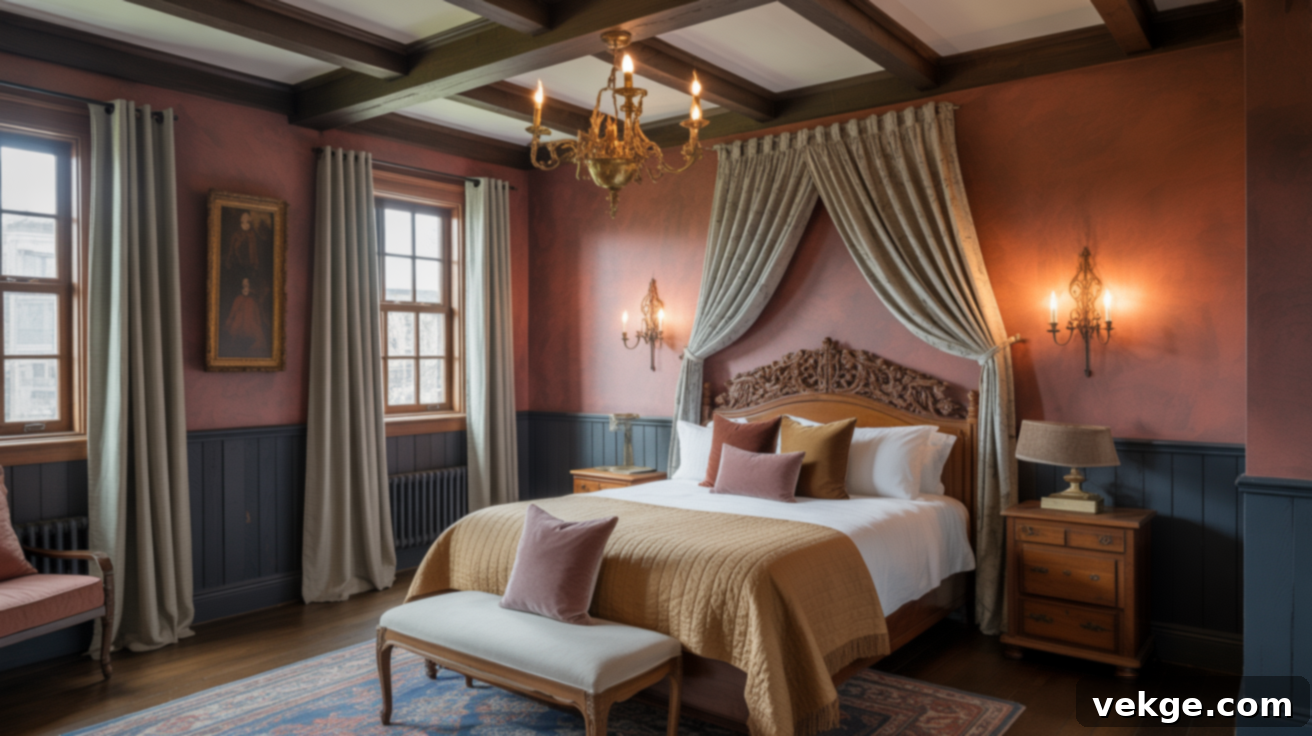
Transform your bedroom into a true Tudor-inspired sanctuary by utilizing deep, enveloping colors on the walls, such as rich navy blue, earthy ochre, or sophisticated warm grey, to immediately establish a cozy and intimate atmosphere. A grand four-poster bed or a romantic canopy frame will serve as a majestic focal point, adding significant weight and presence to the room. Seek out wooden furniture pieces that feature simple, robust lines and showcase visible wood grain, highlighting natural beauty and craftsmanship. Consider applying textured wallpaper behind the bed or above wainscoting to create a luxurious, layered effect. Lighting fixtures crafted from iron or antique brass, including elegant table lamps or a central chandelier, will beautifully tie the entire aesthetic together. Finally, ensure to incorporate an abundance of soft, inviting fabrics such as chunky wool throws, breathable linen bedding, and plush velvet cushions to enhance comfort and visual warmth.
5. Libraries & Studies: The Quintessential Tudor Hideaway
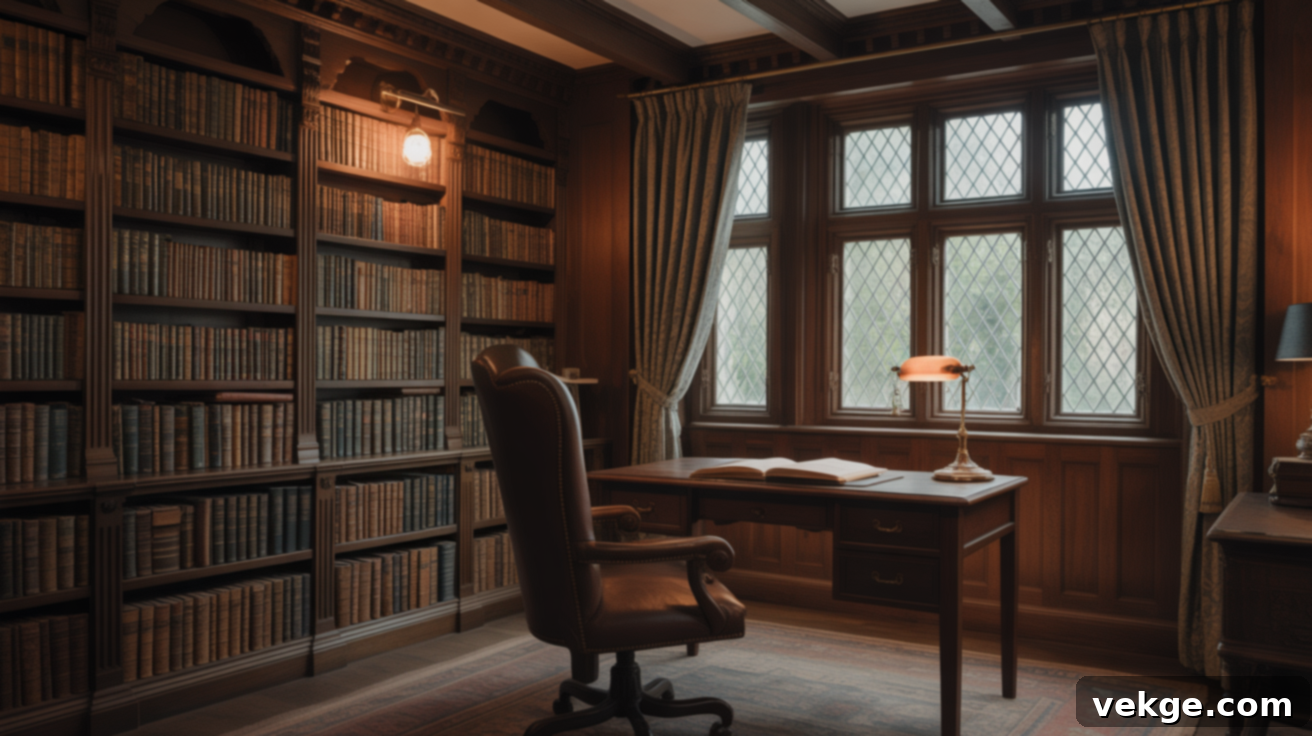
A true Tudor Revival library or study is a haven for contemplation and learning. Begin by installing bespoke built-in bookshelves made from dark-stained wood, or paint existing shelves in a deep, moody tone like forest green or charcoal. These shelves should be abundantly filled with a curated collection of real books, cherished framed photographs, and elegant, functional decorative objects. A luxurious tufted leather armchair or a stately high-back velvet seat positioned near a window creates an ideal reading nook. If your home features a leaded-glass window, capitalize on this architectural gem by transforming it into a charming reading area complete with a comfortable window bench and soft cushions. Complete the space with a substantial, traditional desk and a classic metal-shaded lamp, ensuring the overall palette remains deep and moody, fostering an atmosphere of quiet reflection and intellectual pursuit.
Style Comparison: Tudor Revival vs. Other Similar Architectural Designs

While Tudor Revival homes possess a distinct charm, they are often confused with other historical or revival styles. Understanding the nuances between these architectural approaches can help you appreciate the unique characteristics of Tudor Revival and inform your design choices. Here’s a comparative look:
| Comparison | Tudor Style (Revival) | Arts & Crafts Style | Colonial Style | Original Tudor (Historic) |
|---|---|---|---|---|
| Main Focus | Decorative grandeur and dramatic flair, romanticizing medieval aesthetics. | Simplicity, honesty of materials, and artisanal craftsmanship. | Symmetry, order, and classical proportions. | Historical function, structural honesty, and regional adaptation. |
| Detail Level | Heavy, often ornate woodwork, textured plaster finishes, and intricate leaded glass. | Clean lines with an emphasis on handcrafted details and natural forms. | Balanced, refined detailing, often with classical motifs. | Authentic, often rustic materials, structural expression, and functional elements. |
| Layout Feel | Often asymmetrical, compartmentalized, and inherently cozy. | Practical, grounded, and open, emphasizing connection to nature. | Formal, symmetrical, and often grand. | Built for medieval lifestyles, often with distinct functional zones. |
| Color & Tone | Deep, earthy colors: burgundy, forest green, dark oak, warm creams. | Natural wood tones, muted greens, browns, and craftsman-inspired palettes. | Lighter, crisp shades, often white trim with pastel walls. | Based on the availability of historic, natural resources; often subdued and earthy. |
| Materials | Characteristic use of brick, half-timbering (often decorative), and stone. | Abundant use of wood, local stone, handcrafted tiles, and art glass. | Wood siding, brick, and clean, painted surfaces. | Local stone, wattle and daub, thatch, timber framing. |
| Windows & Doors | Distinctive leaded glass, often with diamond panes, and arched entryways. | Rectangular, functional openings, sometimes with divided lites or stained glass accents. | Symmetrical arrays of double-hung windows, often with shutters, centered entry doors. | Small, often iron-framed panes, practical casement windows. |
| Design Intent | To evoke a sense of mood, depth, and historical romanticism. | To highlight skilled craft, purpose, and a return to simpler forms. | To reflect classical architectural proportion and a sense of establishment. | Built for defense, climate adaptation, and the needs of an agricultural society. |
As you can see, while these styles share a historical root or a “revival” quality, their ultimate design philosophy and aesthetic outcomes are quite distinct. Tudor Revival uniquely marries grandiosity with an intimate, storybook quality that sets it apart.
Tudor Revival on a Budget: Achieving the Look Affordably
Embracing the Tudor Revival aesthetic doesn’t necessarily require an extensive budget or a complete overhaul. With smart choices and a bit of creativity, you can infuse your home with delightful Tudor touches without breaking the bank. Here are some affordable and effective ways to introduce this classic style:
- Faux Finishes with Peel-and-Stick Wallpaper: Explore high-quality peel-and-stick wallpaper options that mimic the look of dark wood paneling, textured plaster, or even exposed brick. This is a temporary, cost-effective way to add visual texture and character to an accent wall or a smaller room.
- Thrift Store and Secondhand Furniture Finds: Hunt for secondhand furniture pieces with classic lines, curved legs, or beautifully turned wood details. A sturdy old oak table, a vintage chest, or a pair of armchairs with character can be refinished or reupholstered to perfectly fit the Tudor aesthetic. Look for solid wood pieces that show their age gracefully.
- Update Lighting Fixtures: Swapping out modern light fixtures for those with a vintage or wrought iron feel can dramatically alter a room’s ambiance. Search for sconces, chandeliers, or pendant lights with dark metal finishes, or even antique-style glass shades at flea markets, antique shops, or online marketplaces.
- Decorative Leaded-Glass Panels: If full leaded-glass windows are out of reach, consider adding framed leaded-glass panels. These can be hung in front of existing windows, inserted into plain door panels, or even used as decorative wall art to introduce that intricate, period-specific detail.
- Introduce Heavy Textiles: A simple way to add Tudor warmth is through textiles. Look for affordable wool throws, tapestry-inspired cushions, or heavy, richly colored curtains in materials like velvet or brocade. These immediately add a sense of luxury and historical comfort.
- DIY Faux Beams: If your ceilings allow, create decorative faux beams using lightweight wood or even polyurethane. These can be stained to mimic dark oak and strategically placed to give the illusion of authentic exposed timber framing without the structural complexity or cost.
Remember, it’s perfectly acceptable to start small. Even the introduction of one or two carefully chosen Tudor-inspired elements can significantly change the feel and character of a room, allowing you to gradually build your desired aesthetic over time.
Helpful Tips for Thoughtful Tudor Revival Integration
Before embarking on any design changes, it’s beneficial to understand certain principles that tend to yield the best results in homes with Tudor Revival architecture. These tips aim to preserve the inherent beauty and integrity of the original structure while allowing for thoughtful, well-integrated updates that feel timeless rather than trendy.
- Preserve Key Dark Wood Details: Resist the urge to paint over every dark wood feature. While brightening elements is a good strategy, try to retain a few key original features, such as a grand staircase, a prominent ceiling beam, or intricate paneling. These elements are the soul of the Tudor style and provide essential contrast when paired with lighter tones.
- Salvage Original Architectural Features: If your renovation plans involve opening up spaces or reconfiguring rooms, make a concerted effort to salvage and reuse original elements. Door frames, window casings, and ceiling beams can often be carefully removed, refinished, and reinstalled, adding an irreplaceable layer of authenticity and character to your updated space.
- Embrace Slow and Deliberate Updates: Avoid rushing into short-lived design trends that clash with the home’s historic age and character. Instead, opt for updates that feel classic and harmonious with the Tudor aesthetic. It’s better to mix in modern elements slowly and thoughtfully, ensuring each addition enhances rather than detracts from the home’s inherent charm.
Above all, strive for warmth, authenticity, and a design that feels honest to the home’s original spirit. Let the unique character and architectural bones of your Tudor Revival home truly guide your design choices, creating a space that feels deeply personal and enduring.
Conclusion: Embracing the Enduring Charm of Tudor Revival
Tudor Revival interiors offer a distinctive and profoundly rewarding design experience: they create rooms that feel authentically real, wonderfully lived-in, and absolutely brimming with character. Throughout this guide, we’ve explored how you can thoughtfully shape each space in your home with purpose, from crafting irresistibly cozy living rooms to designing grounded, serene bedrooms and inviting, contemplative studies.
Remember, embarking on a Tudor Revival transformation doesn’t require doing it all at once. Begin with small, manageable steps. Experiment with elements that genuinely resonate with you and your home’s existing personality. If you’ve ever yearned for a home that radiates warmth, feels deeply rooted, and offers a comforting embrace, rather than one that feels cold or empty, then this timeless style might just speak directly to your soul.
The essence of Tudor Revival isn’t about simply copying the past; it’s about drawing inspiration from history and reinterpreting it in a way that feels honest, personal, and perfectly suited for contemporary living. If you found this guide helpful and inspiring, we encourage you to explore our other posts for even more innovative design ideas and practical, down-to-earth tips to help you bring your vision to life and seamlessly pull all your design elements together.
